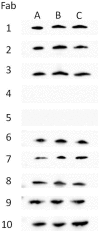Inhibition of toxic shock by human monoclonal antibodies against staphylococcal enterotoxin B
- PMID: 20949003
- PMCID: PMC2952590
- DOI: 10.1371/journal.pone.0013253
Inhibition of toxic shock by human monoclonal antibodies against staphylococcal enterotoxin B
Abstract
Background: Staphylococcus aureus is implicated in many opportunistic bacterial infections around the world. Rising antibiotic resistance and few alternative methods of treatment are just two looming problems associated with clinical management of S. aureus. Among numerous virulence factors produced by S. aureus, staphylococcal enterotoxin (SE) B is a secreted protein that binds T-cell receptor and major histocompatibility complex class II, potentially causing toxic shock mediated by pathological activation of T cells. Recombinant monoclonal antibodies that target SEB and block receptor interactions can be of therapeutic value.
Methodology/principal findings: The inhibitory and biophysical properties of ten human monoclonal antibodies, isolated from a recombinant library by panning against SEB vaccine (STEBVax), were examined as bivalent Fabs and native full-length IgG (Mab). The best performing Fabs had binding affinities equal to polyclonal IgG, low nanomolar IC(50)s against SEB in cell culture assays, and protected mice from SEB-induced toxic shock. The orthologous staphylococcal proteins, SEC1 and SEC2, as well as streptococcal pyrogenic exotoxin C were recognized by several Fabs. Four Fabs against SEB, with the lowest IC(50)s, were converted into native full-length Mabs. Although SEB-binding kinetics were identical between each Fab and respective Mab, a 250-fold greater inhibition of SEB-induced T-cell activation was observed with two Mabs.
Conclusions/significance: Results suggest that these human monoclonal antibodies possess high affinity, target specificity, and toxin neutralization qualities essential for any therapeutic agent.
Conflict of interest statement
Figures


References
-
- Boucher HW, Corey GR. Epidemiology of methicillin-resistant Staphylococcus aureus. Clin Infect Dis. 2008;46:S344–349. - PubMed
-
- Klevens RM, Morrison MA, Nadle J, Petit S, Gershman K, et al. Invasive methicillin-resistant Staphylococcus aureus infections in the United States. JAMA. 2007;298:1763–1771. - PubMed
-
- Maragakis LL, Perencevich EN, Cosgrove SE. Clinical and economic burden of antimicrobial resistance. Expert Rev Anti Infect Ther. 2008;6:751–763. - PubMed
Publication types
MeSH terms
Substances
LinkOut - more resources
Full Text Sources
Other Literature Sources

